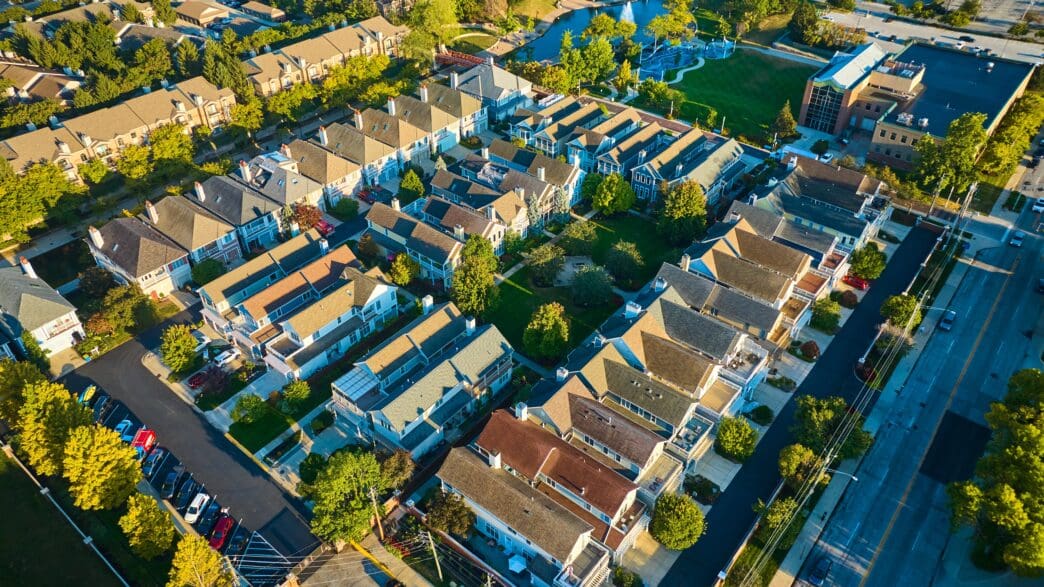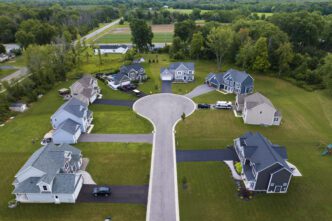Executive Summary
- FHA loan delinquencies increased from 3.7% to 4.8% from mid-2024 to February 2025, driven by borrower financial stress due to inflation, rising insurance premiums, and property taxes, though safeguards prevent a 2008-like crisis.
- Central Indiana’s housing market shows resilience with single-family building permits rising 6% year-over-year for June 2025, contrasting with national slowdowns, but affordability remains a key concern.
- The Fall 2025 Kelley Real Estate Outlook aims to bridge academic research with industry practice, providing data-driven insights into housing market trends and affordability challenges for professionals and the public.
The Trajectory So Far
- The rise in FHA loan delinquencies stems from increased borrower financial stress, primarily due to inflation outpacing wage growth, eroded emergency savings, and escalating costs from natural disasters, insurance premiums, and property taxes. Simultaneously, while Central Indiana’s new home construction shows resilience, the national housing market faces persistent challenges like supply chain delays, rising land development costs, and labor shortages, making affordability a critical concern for both buyers and builders.
Assessing Risk and Value
- The increase in FHA loan delinquencies, driven by rising borrower financial stress from inflation and increased costs, indicates potential risks for investors in mortgage-backed securities, though the presence of strong FHA safeguards helps mitigate systemic threats. While national new home construction faces slowdowns, resilient regional markets like Central Indiana offer localized investment opportunities, yet persistent affordability challenges and broader supply chain and labor issues remain crucial considerations for assessing long-term real estate value and market growth.
Expert Predictions and Forecasts
- Expert analysis indicates a notable increase in Federal Housing Administration (FHA) loan delinquencies, primarily due to heightened borrower financial stress stemming from inflation outpacing wage growth, eroding savings, and rising costs like insurance and property taxes, though robust safeguards mitigate risks of a 2008-style crisis.
- Central Indiana’s new home construction shows resilience with year-over-year increases in building permits, contrasting with slower national trends, yet affordability remains a critical concern for both buyers and builders amidst persistent challenges like supply chain delays, rising land development costs, and labor shortages.
The Indiana University Kelley School of Business Center for Real Estate Studies and Indiana Business Research Center have released their Fall 2025 Kelley Real Estate Outlook, offering critical insights into housing market trends and affordability challenges. The report highlights a significant rise in Federal Housing Administration (FHA) loan delinquencies, primarily attributed to increased borrower financial stress, while also noting resilient new home construction in Central Indiana amidst a national slowdown. This biannual publication aims to bridge academic research with industry practice, providing data-driven analysis for the public and real estate professionals.
FHA Loan Delinquencies on the Rise
Expert analysis by Kelley clinical associate professor of finance Jun Zhu, conducted with colleagues at the Urban Institute, revealed a notable increase in FHA mortgage delinquencies. From mid-2024 to February 2025, the delinquency rate for these loans, designed to make homeownership more accessible, jumped from 3.7% to 4.8%.
Researchers initially considered factors like relaxed lending standards or slowing home price appreciation, but these explanations were disproven. The study concluded that borrowers are experiencing greater financial strain, with inflation consistently outpacing wage growth and eroding emergency savings.
Additional stressors contributing to this financial pressure include an unprecedented frequency of natural disasters, skyrocketing insurance premiums, and property tax increases, particularly impacting newer homeowners. Despite these challenges, Zhu emphasized that enhanced foreclosure-prevention tools and a strong FHA insurance fund provide critical safeguards, differentiating the current environment from the 2008 housing crisis.
Central Indiana’s Resilient Housing Market
Chris Hancock, CEO of the Builders Association of Greater Indianapolis (BAGI), contributed an article examining the state of new home construction, presenting a contrast to national trends. In Central Indiana’s nine-county region, single-family building permits rose 6% year-over-year for June 2025, with total permits up 6% from the first half of 2024.
This performance stands in sharp contrast to national trends, which have seen slower growth in new home activity. However, key challenges persist nationwide, including supply chain delays, rising land development costs, and persistent labor shortages.
Hancock noted that while home prices stabilized in 2025, affordability remains the most pressing concern for both buyers and builders. He concluded that collaboration among builders, policymakers, and community leaders is crucial for Central Indiana to maintain its position as a dynamic and accessible housing market.
Bridging Research and Industry Practice
Curated by Sara Heidtmann Coers, associate director of the Center for Real Estate Studies and lecturer in real estate, the Outlook aims to provide meaningful, data-driven insights beyond surface-level trends. Coers highlighted the report’s goal of making academic research accessible and actionable for industry professionals.
Key Takeaways
The Fall 2025 Kelley Real Estate Outlook serves as an essential resource for understanding the complex forces shaping Indiana’s housing market and broader national trends. By integrating rigorous academic research with practical industry perspectives, the report offers an informed roadmap for real estate professionals navigating current challenges and opportunities.








